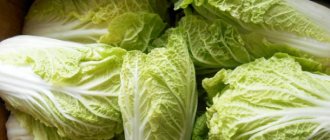Broccoli is a source of vitamin C, potassium, phosphorus, iron and magnesium. This is one of the most useful crops from the Cruciferous family. It takes a lot of effort for gardeners to grow it. Those who want to prepare dishes from this vegetable in winter need to know where and how to properly store broccoli at home.
Storing Broccoli
Preparation for storage
To keep cabbage in the freezer longer, the heads are first washed to remove dirt.
If there are suspicions that pests have infested the plants, the heads of cabbage should be soaked for 30 minutes in a salt solution. After the procedure, they are washed with water, the leaves are removed and, if necessary, cut into inflorescences with a diameter and length of 3 cm. To preserve the color of the broccoli, the heads are soaked in cold water with the juice of half a lemon. The next stage of preparation is blanching. This activity is performed as follows:
- The washed heads are immersed in boiling water.
- Cook the cabbage for 2–3 minutes.
- The inflorescences are immediately thrown into ice water.
You can blanch vegetables in a double boiler. Heads of cabbage prepared by this method retain more vitamins and nutrients. After the event, the blanks are dried and only then sent for freezing.
If you plan to store it in the refrigerator or cellar, do not wash the cabbage. Therefore, when harvesting, monitor the cleanliness of the forks. Heads stained with soil or sand are carefully cleaned with a soft brush. At the same time, they try not to crush or rub the cabbage inflorescences, because the slightest mechanical damage reduces the shelf life of vegetables. You cannot cut off the leaves or shorten the stem from such cabbage, otherwise the shelf life will noticeably decrease.
When is broccoli harvested?
The main rule that gardeners follow when determining the harvest date is that the heads are cut off as late as possible, but they should not bloom. Overripe broccoli loses most of its nutrients and flavor.
Cabbage is harvested until frost, when the size of the inflorescences exceeds 10 cm in diameter. At the same time, bright green buds should be dense and elastic. Broccoli is harvested early in the morning in dry weather. The heads are carefully cut off with a sharp knife, cutting them off along with a fragment of shoots up to 12 cm long.
Attention! Immediately after harvesting the cabbage inflorescences, the broccoli is transferred to a cool place.
Not all heads can be sent for storage. Having collected the inflorescences, they are inspected and sorted. The forks with open buds are put aside and these are eaten in the near future. Dense, elastic heads with a uniform green color, 12–15 cm in diameter, are the best specimens; these are the ones you will work with.
Broccoli harvest
How to choose broccoli for storage
To maximize the potential of plants, most gardeners prefer early varieties of broccoli, although even they have a ripening period of about 90-100 days. (Late varieties ripen in 130-145 days; they can only be used effectively in the southern regions.)
The product is stored exclusively in a cold place (refrigerator or freezer), and the ripening period in this case does not matter.
Broccoli grows quickly in hot weather, so it is important not to miss the ripening period and prevent the heads from overgrowing. The crop should be harvested when the inflorescence does not exceed 15 cm in diameter, with all buds remaining completely closed
During this period, broccoli acquires a rich dark green color and is at its most delicious.
If you notice yellowed parts, it means that some of the buds have already opened. This product can be eaten, but for storage it is better to choose unopened inflorescences.
Choose dense dark green heads with a diameter of 5-15 cm for storage.
Immediately after cutting, broccoli should not be left in the sun, otherwise it will quickly wither. It is best to harvest in the morning or on a cloudy day. It is also not recommended to cut off the heads immediately after watering or rain: cabbage with excessive moisture content rots faster. To harvest, cut off the central head, leaving a stalk about 10-15 cm long. After 2-3 weeks, new small heads will grow on the side stems, which can be eaten or harvested.
Cabbage should be harvested in dry but not hot weather
When choosing a vegetable at the market, give preference to green cabbage (sometimes it may have a purple tint). Make sure that the heads are tight, without mechanical damage or signs of damage. It is better to purchase cabbage for harvesting directly from summer residents, rather than from large wholesalers: this way you will have a much better chance of buying a quality product suitable for storage.
Choosing a broccoli variety for long-term storage
Like any other garden crops, broccoli comes in varieties with different ripening periods. Before sowing the seeds, you need to decide on the choice of cabbage seeds. This will determine when the vegetable ripens and whether it is suitable for winter storage. The fact is that early varieties of broccoli have loose heads that quickly fade.
Mid-season and late hybrids have the best shelf life indicators. They are more resistant to temperature changes and diseases, they can easily tolerate dry periods, which means that such vegetables are able to stay fresh longer.
The best varieties of broccoli for long-term storage:
- Dwarf;
- Fortune;
- Agassi;
- Marathon.
How to store broccoli at home?
Storing broccoli in the refrigerator
This type of cabbage has a very short shelf life - 3-5-7 days. Even if you create the most favorable conditions, we will be talking about a maximum of two weeks. The main thing is to prepare the heads thoroughly. So, before storing broccoli in the refrigerator, you need to: - remove plant products that produce ethylene gas from the refrigerator. As you know, ethylene promotes the ripening of fruits, and in this particular case, accelerates the spoilage of broccoli. Record holders for “gas attacks” are pears, apples, apricots, melons, plums, bananas. — check for defects on the head: mold, brown spots, damage from pests. All this will negatively affect the shelf life of broccoli. Cabbage with bloomed buds, that is, with yellowness, is not suitable for storage. - for short-term storage - and that’s what storing broccoli in the refrigerator is - a long stem is not needed. It is cut off. - provide high air humidity. For broccoli, as for most plant-based products, it is 90-95%. If you are the happy owner of a modern refrigerator, the so-called. “freshness zones”, then the question of ensuring such a high level of humidity and suitable temperature disappears - it is enough to place the vegetable in the “moist freshness” zone. Owners of simpler refrigerators are advised to place a damp paper napkin at the bottom of the vegetable drawer, place the head itself in a bag, but do not close it, and place another moistened napkin on top of the bag. You can do it even simpler - wrap the head with a damp cloth. The temperature for storing broccoli is not below zero and not above ten degrees.
- do not wash the vegetable before storing it - this should be done only before cooking.
Storing broccoli in the cellar
This is where the long stem along with the leaves on it comes in handy. As you know, the lower leaves for cabbage are like a hump for a camel: it is a reservoir of nutrients, and most importantly, moisture. The head, along with the trunk and leaves, is wrapped in paper - each head of cabbage separately, and placed on racks in the cellar. The paper will absorb excess moisture from the air, preventing the appearance of rot on the broccoli, but also “retain” the moisture of the broccoli itself, creating a favorable microclimate and preventing the cabbage from drying out. Perhaps the broccoli will not last until spring, but you will be able to keep the heads in a suitable form for a couple of months.
How to store broccoli in the freezer?
Before you store frozen broccoli, you need to prepare it. Firstly, to preserve the beneficial and taste properties of this product as much as possible, and secondly, to ensure that you get rid of the smallest insects hiding in the branched inflorescences of cabbage.
The sequence of procedures looks something like this: - the heads are washed, the stem and leaves are cut off, and divided into small inflorescences. — dissolve 2 tablespoons of salt in 2 liters of cold water and immerse the inflorescences in the solution for half an hour. This measure will help expel the smallest caterpillars and insects. Then the cabbage is washed under running water. - Blanch with further sharp cooling. So, put the inflorescences into a large saucepan with boiling water, filled half or a little more, and leave for 3 minutes. Then the cabbage is quickly dipped into pre-prepared cold or even ice water for five minutes, thrown into a colander and allowed to drain. - packaged in containers intended for freezing - bags or containers. In this form, the shelf life of broccoli is twelve months.
You can also immerse a cabbage stalk in water like a flower - this will also prolong its life! This can hardly be considered as one of the ways to store cabbage, because we know: a rosebud placed in water will not remain a bud, but will open. The same thing will happen with Brussels sprouts - they will begin to turn yellow and bloom. But it is possible that your out-of-the-box thinking will allow you to extract an interesting life hack from this opportunity.
Few vegetables are so strongly associated with a healthy diet today as broccoli. The fresh storage of this vegetable, however, is so short that people often wonder: should I try to store it in the refrigerator or freeze it? The answer is: if you do not have a cellar, and the expected shelf life exceeds 7 days, it is better to freeze the vegetable. It’s better this way than after two weeks to be content with limp, yellowish inflorescences that have lost the lion’s share of vitamins.
You can read about how to store cauliflower in our next article.
Tatyana Kuzmenko, member of the editorial board of the online publication “AtmAgro. Agroindustrial Bulletin"
Harvest
How to remove broccoli for storage? Proper harvesting of broccoli is the key to successful storage. The shelf life depends little on what kind of refrigerator you have and how the cabbage is stored there.
It depends much more on what happened to the cabbage before storage in the refrigerator. If harvested incorrectly, cabbage quickly withers, turns yellow and subsequently spoils .
Such cabbage is no longer worth eating, since its culinary value is reduced to a minimum. You can avoid this by following important rules when cleaning:
- Harvest broccoli during the coolest hours of the day to keep it warm. Cabbage is very sensitive to it and immediately begins to wither.
- Cut the broccoli not exactly under the head, but 10-12 cm lower .
- Do not tear off the head, but carefully cut it so as not to damage the stem , which will remain on the garden bed! It will still be needed.
- Broccoli is resistant to low temperatures, but not lower than -2 °C . Otherwise the cabbage will simply freeze.
After harvesting, the harvest should be stored in the refrigerator as quickly as possible to minimize exposure to heat . It is recommended to do this within 30 minutes maximum. Therefore, it is advisable to choose a storage method in advance and, if possible, prepare everything you need to remove the cabbage right away.
It was mentioned above that cut stems in the garden will come in handy later. The fact is that they can produce young side shoots with small inflorescence heads up to 6 times, which will provide an additional harvest . Young heads are ideal for storing in the refrigerator and freezer. It would be a sin not to take advantage of this.
You can find out how to properly and at what time to harvest white cabbage, cauliflower, as well as kohlrabi and Brussels sprouts on our website.
Storage periods and rules
Cabbage is considered a perishable product, which, under the influence of various weather and temperature conditions, instantly withers and loses its taste and commercial properties. However, provided low temperatures and optimal humidity are maintained, broccoli fruits from the garden can be stored for quite a long time. In this case, it is necessary to take into account the characteristics of the variety, as well as to know exactly when to harvest the crop, since this directly affects its safety.
Fresh
Since this cabbage fades quickly, there is no way to store it fresh for a long time. Usually, under optimal conditions, cabbage is stored for several weeks, but for this, the crop must be well prepared after harvesting. The heads are thoroughly washed in cold water and then trimmed. This best protects vegetables from premature wilting or rotting. Store broccoli at a temperature of 0...+5°C in a special compartment for vegetables in the refrigerator. Only here is the humidity necessary for long-term storage observed.
Precise adherence to agricultural techniques for cultivating the crop will help to more effectively extend the season for consuming fresh cabbage. This involves gradual harvesting throughout the active growing season. The heads are plucked one at a time, so the broccoli ripens in small portions throughout the season.
Frozen
It is believed that broccoli is practically unsuitable for long-term freezing, but under favorable weather conditions, when the vegetable grows and ripens quite quickly, and it has to be harvested almost every day, the need for long-term freezing becomes simply necessary.
Important! Only late varieties of cabbage are suitable for freezing, since early varieties do not have the necessary shelf life and usually spoil quickly even at low temperatures. In this case, you can store cabbage for 6 months, which makes it possible to use the fruits for cooking only when needed.
The vegetable requires special preparation for freezing, without which it will instantly spoil in the freezer
In this case, you can preserve cabbage for 6 months, which makes it possible to use the fruit for cooking only when needed. The vegetable requires special preparation for freezing, without which it will instantly spoil in the freezer.
This is done like this:
- Wash the cabbage thoroughly and remove dry parts and stems.
- Separate the heads into small florets and then soak them in a saline solution (1 tbsp/1 liter of water) for about 30 minutes.
- Rinse the cabbage under running water and then boil in boiling water for 3 minutes.
- After cooking, plunge the hot vegetable into ice water for 5 minutes. Be sure to add a few ice cubes to the liquid.
- Dry the broccoli and then pack it in plastic bags or food containers.
Optimal conditions
Broccoli cannot be kept warm for a single extra minute, and also requires constant high humidity . Therefore, the only suitable storage location is in the refrigerator (or frozen in the freezer).
Storage conditions: temperature from 0 to 10 °C and humidity 90-95%. This is the reason why you can’t keep broccoli in your apartment.
But even if the conditions and rules of preparation and storage are observed, broccoli can last fresh for a maximum of two weeks, more often - no more than a week . The only way that will provide you with broccoli for 6-12 months after harvest is to freeze it.
Advantages of the method
Freezing has many advantages, and the main ones look like this:
Convenient storage. Frozen cabbage of this type does not take up much space in the freezer, does not absorb odors and can retain all its nutritional properties for a long time. Preservation of beneficial properties. Freezing, unlike other methods of food storage, allows you to almost completely preserve a range of useful characteristics and a range of taste qualities. If all manipulations are carried out correctly, following the instructions, the product will hardly differ from fresh in taste, color, or vitamin content.
This is especially important for those who plan to cook broccoli for a child, since freezing the vegetable for the winter and preparing delicious food for children from it is extremely useful. The product is always at hand, which saves a lot of time. There will be no need to visit the store every time to prepare a healthy breakfast or lunch for the family.
Broccoli will always be at home in a form that is completely ready for heat treatment and serving. Saving money. It's no secret that vegetables in winter are much more expensive than in season. Therefore, by purchasing food at a time when the price is low and freezing it, during the winter you can use broccoli to prepare nutritious meals, without spending your family budget on expensive products in the store.
Did you know? Recent studies claim that the variety of cabbage in the form of broccoli appeared not as a result of natural evolution, but thanks to breeding work. The northeast Mediterranean is considered the birthplace of the vegetable. At first, this crop was cultivated in Ancient Rome. For a long time nothing was known about her outside of Italy. Only over time, the vegetable came to Turkey (then Byzantium) and then spread throughout the globe.
When to Harvest
Broccoli should be cut for storage as late as possible, but it is important not to allow it to become overripe. It is better to choose a cool and cloudy day, or go out into the garden to collect early in the morning or late in the evening. Do not wait for frost, otherwise the entire harvest will be lost.
When cutting, leave a stem about 15 cm long. If the day is warm, do not leave the cabbage heads lying in the open air. Take them immediately to the cold, because broccoli loses its taste very quickly and loses its elasticity. Literally after half an hour of “rest” in the shade, 30% of the nutrients are lost.
In the freezer
Storing broccoli for the winter is only possible in the freezer. Vegetables of late-ripening dark green varieties are suitable for long-term storage. The heads should be dense, 10-12 cm in diameter, without yellow spots, with large central inflorescences.
Compliance with proper freezing conditions will preserve the maximum of nutrients and the appetizing appearance of cabbage. Divide the cabbage head into several parts. Soak them for 30 minutes in a saline solution (4 tablespoons of rock salt per 4 liters of cold water) or vinegar (2-3 teaspoons of vinegar per 4 liters of water) solution. This is necessary to drive insects out of the broccoli and wash away dirt from it. After soaking, rinse the vegetable under running water and divide into inflorescences, approximately 3 cm in diameter. Next, the vegetable must be blanched. Fill a deep saucepan 2/3 full with water and place on fire. When the water boils, lower the inflorescences into it so that they are completely submerged. After 3 minutes, remove them from the boiling water and plunge them into ice water for 5 minutes. Place the cabbage in a colander and let the liquid drain well. Pack the inflorescences in bags or plastic containers suitable for use at low temperatures. If possible, pump out the air from the container. Place it in the freezer and turn on the “fast freeze” function. At a temperature of -15..-20˚C, broccoli can be stored for up to 6 months.
Freezing is an excellent way to store all types of cabbage: white cabbage, cauliflower, Peking cabbage. Now you know how to store broccoli at home, and you can delight your family with dishes using this healthy and tasty product all year round.
Useful tips
If you want to serve broccoli dishes all year round, it's easy to do:
- Plant several varieties with different ripening periods. Then already in the middle of summer it will be possible to cut the first harvest. Late broccoli will keep well if you follow our tips.
- When you harvest your last harvest, divide it into three parts. Put the first, small one in the refrigerator and eat it first. Place the second part in the cellar. And when you use it up, it will be the turn of frozen broccoli, which will not lose its quality until late spring.
If you are already an experienced gardener, then I would like to hear how you store broccoli. Do you have any proven methods you could share?
How long can cabbage be stored in an apartment?
A piece of white cabbage that is not prepared for long-term storage, that is, not wrapped in a paper bag or wrapped in cling film, can be stored at room temperature for no more than seven days. Storing cabbage on the balcony, subject to all the above recommendations, will give you the opportunity to eat fresh produce until June.
Remember
Cabbage in film can be preserved for five months. When frozen, it stays fresh for about 10 months. The shelf life of dried vegetables is one year. In a dry, ventilated pantry, cabbage wrapped in cling film can be stored for several months.
The main thing is to preserve cabbage in an apartment for the winter, you need to understand that this is possible at a constant temperature from minus 1 degree to plus 5 degrees Celsius. Humidity at low temperatures can reach 95 percent, at high temperatures - 80 percent. Of course, it is almost impossible to achieve such values (the refrigerator does not count), and therefore it is better not to store white cabbage for a long time.
Other types of cabbage may not remain in the refrigerator for long. For example, the shelf life of broccoli, cauliflower and peking broccoli is only a couple of weeks. Kohlrabi, however, takes a little longer - 30 days.
How to Store Broccoli Heads in the Refrigerator
The easiest way to keep broccoli fresh in the refrigerator is to place the cabbage in a plastic bag with several holes in it for ventilation.
Another good way is to place cabbage forks in a container of water. You only need a little bit of water, no more than one centimeter. Check to see if you can leave open containers with liquid in your refrigerator. If excessive evaporation of water can damage household appliances, then do this:
- choose a wide bowl and pour in some water;
- stretch cling film over it;
- make a small hole the size of the stalk;
- insert the forks into this hole so that the edge of the leg is in the water.
How to pickle broccoli the classic way
We'll tell you how to pickle broccoli using a classic recipe as an example. The preparation will require the following ingredients:
- broccoli inflorescences - 400 g;
- carrots - 2 pcs.;
- garlic - 6 cloves;
- fresh dill - several sprigs;
- bay leaf - 2 pcs.;
- black peppercorns - 15 pcs.;
- sugar - 10 tbsp. l.;
- salt - 4 tbsp. l.;
- water - 1 l;
- Sunflower oil - 200 g;
- vinegar 9% - 1 tbsp.
Preparing the snack is not particularly difficult. If you know how to prepare white cabbage, then you can easily cope with this recipe.
How to pickle broccoli:
- The forks are divided into inflorescences, washed and dried. Carrots are cut into rings or cubes. Garlic is passed through a press. Dill is chopped.
- Vegetables and herbs are mixed in one container and then placed in sterilized jars.
- To prepare the marinade, boil water. Sugar, salt, vegetable oil, bay leaf and pepper are added to it. Boil for 10 minutes, add vinegar and remove from heat.
- Pour the hot marinade over the vegetable mixture. The jars are rolled up and left for 2 days in a dark place at room temperature. Then they are stored in the refrigerator.
Interesting Facts
There are varieties of branched broccoli. She uses tender shoots with undeveloped buds for food. Just like regular broccoli, after removing the central shoot, thin lateral shoots up to 20 cm long grow in a few weeks. After boiling in salted water, they become similar in taste to asparagus. Cook them the same way as regular broccoli - 8-10 minutes. They can be prepared for future use by blanching, and then placed in plastic bags and frozen in the freezer.
How to preserve broccoli longer
Cabbage cannot stay fresh for long at room temperature, but there are a few simple ways to preserve the elasticity of the inflorescences in the refrigerator.
In a refrigerator
The easiest option is to simply put the cabbage in the vegetable section. A stable low temperature in the chamber will preserve the vegetable for 5–7 days.
To preserve cabbage longer, use one of the popular methods.
In a container of water
One of the simplest options is to make an impromptu bouquet of cabbage.
Partially submerged in water, the vegetable will remain fresh for up to 9 days:
- Pour a little water into a container of suitable size (up to a 2 cm layer).
- Broccoli is placed so that the inflorescences are on the outside.
- The fork is covered with a thick plastic bag, in which several holes are made for ventilation.
In this state, the product is sent to the refrigerator. The water is changed every day.
In a paper towel
The second option involves wrapping the fork in a thick paper napkin or towel. This method is simpler, but the shelf life of the product is no more than 4 days:
The inflorescences are lightly sprayed with water from a spray bottle. Each fork is wrapped in a paper towel so that it absorbs excess moisture. It is important that the napkin does not fit tightly to the inflorescences, otherwise ventilation will be disrupted.
The broccoli wrapped in a napkin is placed in the refrigerator and checked periodically. The first to be consumed are those inflorescences that show signs of spoilage or wilting.
In a plastic bag
If you need to save broccoli for 3 days, but there is no time to constantly monitor the inflorescences, use this option:
- Take bags made of thick cellophane and make several holes in them for ventilation.
- Place one fork in each bag. Tie the packaging tightly and put it in the refrigerator.
This method is not suitable for long-term storage, since condensation gradually accumulates in the bag, despite the presence of holes. This leads to rapid rotting of the product.
How to keep broccoli fresh for the winter
The freezer is suitable for this. Frozen vegetables retain all their taste and beneficial properties for up to 1 year.
To properly freeze broccoli, follow these instructions:
- The heads are washed, the stems and leaves are removed, and the forks are divided into several parts.
- The pieces are placed in a saline solution for 30 minutes and then washed under running water.
- Place the broccoli in boiling water, cook for 3 minutes and drain in a colander. When the moisture has drained, the vegetable is immediately placed in a bowl of ice water for 5 minutes.
- The inflorescences are again placed in a colander. When excess moisture has drained, dry on a paper or cloth towel.
- Completely dry heads are laid out in a single layer on a large plate or tray and placed in the freezer. It is better to turn on the fast freezing mode, if there is one, so that the product sets instantly.
Frozen cabbage is portioned into bags or containers and sent to the freezer. Repeated freezing of broccoli is unacceptable.
In the cellar
A cool and dry cellar is suitable for storing broccoli for the winter.
To successfully preserve cabbage until the next harvest, follow these rules:
All outer leaves are removed from the heads. Vegetables are placed in wooden boxes, baskets or simply on shelves
It is important that they have holes for ventilation. The bottom must be lined with fabric. The forks are laid out so that they do not touch each other
It is advisable to wrap each head with thick paper and change it as it gets wet.
When storing vegetables in the basement, they are periodically inspected and damaged ones are removed, since one rotten specimen will cause damage to the rest.
Method for storing broccoli in the basement
For storage in the basement, three things must be observed:
- temperature from 0° to 3°;
- high humidity;
- good ventilation.
Plastic boxes with holes are best for storing broccoli. Their bottom should be covered with a damp cloth. Place the cabbage heads with the stem on the cloth. Try to keep the forks touching each other as little as possible.
To maintain moisture, stretch a piece of plastic wrap over the box. The cellophane should not touch the cabbage; there should be a small gap between them. There is no need to cover the holes in the sides of the drawers. This will help prevent rotting.
The humidity should be checked periodically. If necessary, spray the bottom of the box with water from a spray bottle. Water should not get on the heads of cabbage!
How to properly store greens in an apartment
Green leaves quickly dry out and turn yellow in the sun. Bunches laid out in several layers become stubborn and wither. The best way to preserve green vegetables indoors is to place them in water or wrap them in a damp cloth. In the refrigerator, the freshness of the leaves will maintain the temperature in the vegetable compartment.
Parsley and dill
For cold storage, dried bunches are placed in thin cellophane, wrapped in cling film, and placed in plastic boxes. The chopped seasoning is stored in the freezer in polyethylene.
Shallot
The variety is stored like regular onions, in boxes or bags. Unpeeled shallots will keep for 7 months. Without the husk, it is stored in the refrigerator in plastic containers.
Spinach
The product is usable within 24 hours after collection, regardless of storage location. Then toxins accumulate in it. That's why you can't find fresh spinach in supermarkets.
Watercress
Cut leaves are negatively affected by heat. The lettuce variety is placed in plastic containers and placed in the vegetable drawer or on a shelf on the refrigerator door.
Celery
The leaves become soft in cellophane, so they are wrapped in foil and refrigerated. In room conditions they keep the water fresh. The roots of grown celery are stored in boxes with sand, in plastic bags, in an aqueous solution of clay.
Deciduous herbs
Cilantro, tarragon, basil, mint will stand for 2 days in water. In the cold, greens will last 5 days, wrapped in a damp towel.
Arugula
Freshly picked grass will also stand like a green bouquet in water. Large quantities of leaves are packed in zip bags or vacuum sealed and stored in the cold for no longer than a week.
Fennel
Stored at +6…+8 degrees, isolated from other products. A plastic container or wet towel will stop the aroma from spreading.
Advice from experienced pp specialists
It is better to cook broccoli and cauliflower in enamel pans - their coating is inert and will not react in any way to the acids contained in them.
It is better to store frozen vegetables in the freezer for no longer than 9 months, then both the beneficial and taste properties deteriorate.
Before you cook frozen cauliflower, it is not necessary to defrost it, unless you will be frying it in batter (which is not very suitable for pp-shnik).
Irina Polyanitsa My name is Irina, I am the owner and admin of the site, as well as the author of most of the recipes and articles. I love to cook simple and healthy delicacies. Certified gym instructor, personal trainer. She completed a course on nutrition and health at Stanford University, Stanford Introduction to Food and Health, as well as a course at Ludwig Maximilian University of Munich (LMU) Nutrition and Lifestyle in Pregnancy (about nutrition and lifestyle during pregnancy).
Alternative storage methods
In addition to the above methods, to store broccoli fresh or frozen, it can also be dried and pickled.
Drying
Drying should be done in a special dryer or oven. This method allows, just like freezing, to preserve the maximum amount of valuable substances in the vegetable. You can dry cabbage either whole (if it is small) or cut into pieces.
The easiest way to dry is in a dryer. The cabbage needs to be washed, dried and cut, placed in a tray in one layer and set the required time for drying the vegetables (6-8 hours) and the temperature +45...+80°C.
Did you know? There is no broccoli that grows in the wild: this cabbage was created through hybridization. It is known that it was cultivated back in the 6th–5th centuries BC. e. in the Mediterranean.
The oven drying technology is as follows:
- Divide the head into inflorescences.
- Wash and soak in saline solution.
- Blanch - place in boiling water for 3-5 minutes.
- Dry for an hour.
- Preheat the oven to a temperature of +50…+100°C.
- Place the cabbage on a baking sheet.
- Place in a preheated oven for 3–5 hours, at regular intervals (once every 30 minutes), checking the readiness of the product and turning it over. The door does not need to be closed completely. If the oven supports convection mode, it should be activated.
Pickling
Broccoli can also be preserved by pickling. The advantages of this method are that the product can be preserved for a long time, and it also has a piquant taste. By adding various ingredients and spices, you can get a product with a completely different taste, which can later be used as an independent dish or as one of the ingredients, for example, in salads. The disadvantages of the method are the loss of a large amount of valuable substances.
How to cook broccoli
The vegetable is rich in many beneficial qualities, so introducing it into your diet will be the right decision. This cabbage improves skin condition. It is also beneficial for pregnant women, as broccoli contains folic acid. Thanks to it, you can maintain the normal state of the body. This cabbage is so healthy that it can only be harmful if you are hypersensitive. She has no further contraindications identified at this time.
It is important to wash the vegetable before use so that it brings the maximum amount of benefit.
In cooking, broccoli is used in a variety of dishes. It is suitable for frying, boiling and steaming. The vegetable can also be eaten raw, as it will retain many useful substances in this form. Broccoli is healthy - all its components. To eat this cabbage raw, you should add it to the salad. Broccoli can be combined with other vegetables. Can be used with butter or sour cream. For fish or meat, this vegetable will be a wonderful side dish. These methods of consumption are the most useful.
But if you don’t want to eat broccoli raw, you can cook it. But when treated with heat, many useful substances disappear. Therefore, it is worth putting it closer to the end of cooking. Broccoli doesn't take long to cook. This will help preserve the maximum amount of beneficial qualities of the vegetable. Stewing or steaming are most suitable in this case. If you put it in a microwave oven, then it will lose almost all its beneficial properties. Currently, you can buy fresh and frozen broccoli in the store. The shelf life of broccoli in the refrigerator is about 7 days . A container is suitable for storing it. To preserve cabbage for a longer time, you can freeze it. In this case, it needs to be washed and disassembled into inflorescences. They need to be dried and then put in a bag. The shelf life of broccoli in the freezer is 6 months .
Short-term storage in the refrigerator
How to store broccoli in the refrigerator:
- Spray each head with clean water from a spray bottle.
- Then wrap in a clean cotton napkin or towel.
- Place in the refrigerator and enjoy the fresh taste and aroma for 3-4 days.
Proximity to vegetables and fruits that emit ethylene harms broccoli
You can find a list of ethylene-emitting vegetables and fruits that are undesirable for broccoli in the article about storing fresh cucumbers.
It will help to preserve broccoli by simply wrapping it in a damp paper towel or packing it in plastic bags (no need to close them). Afterwards, the valuable product is placed in a cool place, where it will remain fresh for 2-3 days.
How to keep cabbage fresh for the next week? Make a green bouquet, place it in a jar of water, and cover with a bag on top. Change the water every day, and make holes in the plastic for air circulation. Keep broccoli in the refrigerator and enjoy freshness for 6-7 days.
Do you know that…
It is unacceptable to keep cabbage in a tight plastic bag or an airtight container. In order for it to retain its nutritional value and not become moldy, it needs constant access to fresh air.











